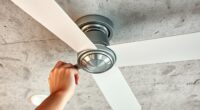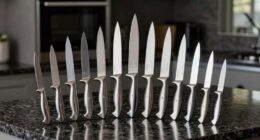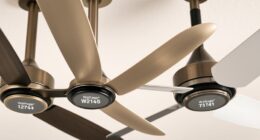To optimize comfort and energy efficiency, set your ceiling fan to spin counterclockwise in summer to create a cooling breeze, and clockwise in winter to push warm air downward. Properly adjusting fan direction can markedly impact airflow, heating, and cooling costs, but many overlook seasonal changes. Understanding how to switch your fan’s rotation and maintain it properly ensures better ventilation year-round. Keep exploring for more tips to master your ceiling fan’s performance.
Key Takeaways
- Ceiling fans rotate counterclockwise in summer for cooling, and clockwise in winter to distribute warm air evenly.
- Proper fan direction adjustment enhances energy efficiency and indoor comfort across seasons.
- Fan blades should be tilted and designed to optimize airflow during seasonal changes.
- Using remote controls or switches makes seasonal direction adjustments quick and safe.
- Regular maintenance and correct operation prevent cold spots in winter and excessive cooling in summer.
Understanding Ceiling Fan Rotation: How It Works
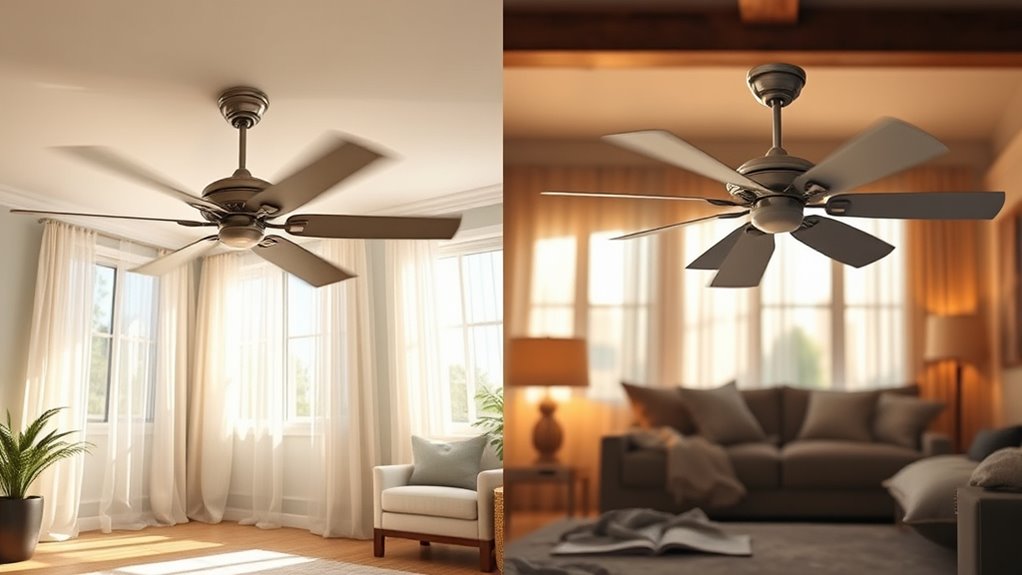
Ceiling fans rotate in different directions to help control indoor temperature, and understanding how this works is key to maximizing their efficiency. The key factors are blade pitch and motor rotation. Blade pitch refers to the angle of the blades, which influences how much air is pushed down or pulled up. When the motor rotates clockwise, the fan typically runs in a winter mode, pulling air upward and creating a gentle upward airflow. Conversely, counterclockwise rotation pushes air downward, providing a cooling breeze. Adjusting the motor rotation changes the direction of airflow. A slight change in blade pitch or motor rotation considerably impacts how effectively your fan circulates air, helping you maintain a comfortable indoor environment year-round. Additionally, air circulation technology in modern fans can further optimize airflow patterns for increased comfort.
The Correct Fan Direction for Summer Cooling

Wondering how to keep your room cool during summer? The key is setting your ceiling fan to spin counterclockwise. This direction pushes air downward, creating a breeze that cools the room. The fan blade design plays a role here; blades angled to maximize airflow are most effective in this setting. Make certain your electrical wiring is correctly connected so the fan operates smoothly in this mode. Most fans have a switch on the motor that allows you to change direction easily, but confirming the wiring connections helps prevent any issues. When set correctly, your fan creates a wind-chill effect that makes the space feel cooler without lowering the temperature. This simple adjustment can greatly improve comfort during hot days. Additionally, ensuring proper air circulation enhances overall cooling efficiency and comfort.
Adjusting Fan Spin for Winter Heating Efficiency

To improve winter heating efficiency, you should guarantee your fan rotates clockwise at a low speed. This correct fan rotation helps with ideal air circulation, pushing warm air down and around the room. By adjusting your fan spin properly, you can save energy and stay cozy all season long.
Correct Fan Rotation
Adjusting your fan’s rotation direction is essential for maximizing heating efficiency during winter. When set correctly, the fan blades should rotate clockwise, pushing warm air down and evenly distributing heat. The fan blade materials, like wood or metal, influence how smoothly the blades turn and how well they maintain balance during adjustment. If your fan has remote control features, use the reverse switch remotely to make quick adjustments without climbing a ladder. Verify the fan is set to rotate slowly in the correct direction, as a faster spin can cause discomfort or inefficiency. Properly adjusting the fan’s rotation helps retain heat in the room, reducing the workload on your heating system and lowering energy costs. Regularly monitoring your fan’s behavior can help identify potential AI vulnerabilities that might affect its performance. Always double-check your fan’s manual for specific instructions related to your model.
Optimal Air Circulation
For ideal winter heating, you should guarantee your fan spins in a way that promotes even air distribution. Proper airflow patterns help prevent cold spots and ensure warm air circulates throughout the room. To achieve this, set your fan to rotate clockwise at a low speed, pushing air upward. This creates an invisible column of warm air near the ceiling that gradually descends, maintaining a comfortable temperature. Fan placement also matters—install the fan centrally for balanced airflow, especially in larger spaces. Avoid placing fans near walls or corners, which can disrupt airflow patterns. Maximize space and organization by ensuring your fan placement and settings are optimized for efficiency. By adjusting your fan’s spin direction and ensuring optimal placement, you maximize heating efficiency and enjoy consistent warmth without wasting energy.
Energy Saving Tips
By setting your ceiling fan to spin clockwise at a low speed during winter, you can substantially reduce heating costs. Use your remote control to easily switch the fan direction and adjust the speed without hassle. The fan blade design plays a vital role in efficiency; blades angled for winter circulate warm air downward, creating a gentle upward draft that pushes heated air along the ceiling. This process helps maintain a consistent temperature and reduces the workload on your heating system. Keep the fan running at a low, consistent speed to optimize energy savings without creating drafts. Properly configuring your fan in winter ensures comfort while lowering energy bills, making your home more efficient and eco-friendly. Additionally, understanding personality traits can help you better manage household dynamics and enhance overall comfort during seasonal changes.
Common Mistakes in Fan Direction Settings
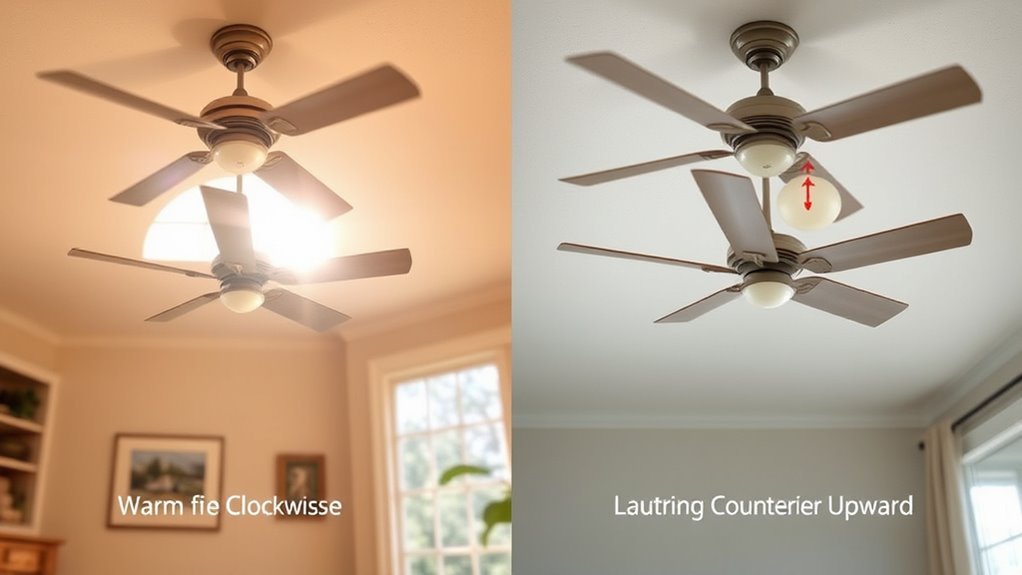
Many homeowners make the mistake of setting their ceiling fans in the wrong direction for the season, which can lead to increased energy bills and discomfort. A common error is neglecting to adjust fan blade angles or relying solely on remote control features without understanding their full capabilities. For winter, fans should rotate clockwise with a slight tilt in the blades to push warm air downward, but many overlook this or forget to switch settings. Similarly, during summer, fans should run counterclockwise with blades angled for a strong downward breeze. Failing to verify these settings can negate the fan’s effectiveness. Always double-check your remote control features to ensure you’re using the correct mode, and consider adjusting the fan blade angles if possible for maximum airflow. Additionally, understanding fan direction settings can significantly improve energy efficiency and comfort throughout the seasons.
The Impact of Fan Speed and Tilt on Ventilation

Adjusting your fan’s speed and tilt directly impacts how well air circulates in your space. Higher speeds can boost airflow efficiency, but may cause discomfort if set too high. Proper tilt guarantees better ventilation and comfort, depending on your needs. For optimal results, selecting the right fan design and features can further enhance airflow and cooling efficiency. fan design and features
Airflow Efficiency Variations
Fan speed and tilt considerably influence airflow efficiency, affecting how well ventilation performs in different settings. Higher fan speeds can increase airflow but may cause uneven distribution if the fan blade design isn’t essential. Similarly, tilting the fan slightly can improve air circulation, but excessive tilt reduces efficiency. Your fan blade design plays a pivotal role, with aerodynamically shaped blades generating more consistent airflow at various speeds. Proper fan placement strategies also matter; placing fans centrally or near air vents maximizes coverage and minimizes dead zones. Adjusting speed and tilt based on your room’s layout ensures ideal airflow, reducing energy waste and improving ventilation quality. Understanding these variations helps you tailor your fan use for better air circulation year-round, especially when considering airflow efficiency and how different settings impact overall ventilation performance.
Comfort Level Adjustments
Optimizing airflow through speed and tilt settings directly influences how comfortable a space feels. Adjusting fan speed helps regulate humidity control, making the environment less muggy or damp, which boosts comfort. Higher speeds create a stronger breeze, ideal for hot summer days or quickly cooling a room, while lower speeds offer gentle airflow for a more relaxed atmosphere. Tilt adjustments direct airflow where you need it most, enhancing ventilation and preventing drafts. Properly set, a ceiling fan can also serve as an aesthetic enhancement, complementing your room’s decor. Additionally, research indicates sound vibrations are believed to enhance cellular regeneration and overall health. By fine-tuning these settings, you maintain ideal comfort levels regardless of the season, ensuring the airflow feels natural, not disruptive, and contributes to a more pleasant living space.
Tips for Easy Seasonal Fan Adjustments

Changing your fan’s direction seasonally can make a noticeable difference in your comfort and energy bills. Adjusting the fan blades’ rotation ensures *ideal* airflow during summer and winter. To make this switch simple, follow these tips:
Adjust your fan’s direction seasonally for better comfort and lower energy bills.
- Familiarize yourself with your fan’s remote or switch for quick adjustments.
- Remember to turn off the fan before changing blade direction for safety.
- Use fan maintenance tips to keep blades clean and efficient, improving airflow.
- Consider decorative fan styles that easily accommodate seasonal changes.
- Label the switch with clear instructions for each season to avoid confusion.
- To ensure optimal operation, check your fan’s motor compatibility with different directions, as some models may have specific requirements for safe and effective use.
When to Consider Upgrading Your Ceiling Fan System

If your current ceiling fan no longer meets your comfort or energy efficiency needs, it’s time to contemplate upgrading. Over time, fan maintenance becomes more challenging, and the fan may develop excessive noise, signaling aging components or worn bearings. If cleaning or balancing the blades doesn’t reduce fan noise, or if your fan struggles to circulate air effectively, upgrading is a smart choice. An older fan can also consume more energy, increasing your utility bills. Modern fans feature improved motor technology, quieter operation, and better airflow. Upgrading ensures you enjoy heightened comfort year-round, whether adjusting for summer or winter. Recognizing these signs helps you decide when to replace your ceiling fan system for enhanced efficiency and a quieter, more reliable performance. Additionally, considering the energy-efficient features of newer models can further reduce your utility costs over time.
Frequently Asked Questions
How Can I Tell if My Ceiling Fan Is Rotating Correctly?
To tell if your ceiling fan is rotating correctly, start with a motor rotation test by turning it on and watching the blades. If the fan’s blade alignment is correct, the blades should spin smoothly in a consistent direction. For summer, blades should spin counterclockwise to create a breeze, and clockwise for winter. If it’s not, adjust the fan’s direction switch and re-test to make certain of proper rotation.
Do Different Ceiling Fan Models Have Unique Directional Settings?
You bet different ceiling fan models have unique directional settings. Some fans come with a switch or remote that adjusts blade angles or motor compatibility to change rotation direction, while others might require manual adjustments. Always check the manufacturer’s instructions, as not all fans are built the same. Think of it as a tailored suit—knowing your specific model guarantees you get the perfect airflow, whether it’s summer or winter.
Can Fan Direction Impact Indoor Air Quality?
Yes, fan direction can influence indoor air quality by improving air circulation and indoor comfort. When you set your ceiling fan to rotate clockwise in winter, it pushes warm air down, reducing stagnant spots and enhancing ventilation. Conversely, in summer, a counterclockwise setting promotes airflow, helping to disperse odors and pollutants. Proper fan direction guarantees better air movement, making your indoor environment healthier and more comfortable.
Is There an Optimal Fan Speed for Energy Efficiency?
You should set your ceiling fan to a moderate speed for ideal energy efficiency. Higher speeds increase energy consumption without considerably improving fan performance, while lower speeds may not circulate air effectively. By choosing a balanced setting, you reduce energy use and maintain good airflow. Adjust your fan speed based on room conditions; this helps save energy and keeps your space comfortable without overworking your fan.
How Often Should I Check or Adjust My Ceiling Fan’s Direction?
You should check and adjust your ceiling fan’s direction seasonally, ideally every few months, to optimize airflow patterns. Regular fan maintenance guarantees it’s functioning correctly and helps you spot any issues early. If you notice uneven airflow or noise, it’s time to adjust the fan’s direction. Doing this keeps your space comfortable and energy-efficient year-round, preventing unnecessary strain on your fan and reducing energy costs.
Conclusion
By understanding how to adjust your ceiling fan’s direction seasonally, you can save energy and stay comfortable year-round. For example, imagine a homeowner switching their fan to clockwise in winter, reducing heating costs without sacrificing warmth. Small tweaks make a big difference—so take the time to set your fans correctly and enjoy efficient comfort all year long. Proper fan use isn’t just about comfort; it’s about smarter, cost-effective living.

